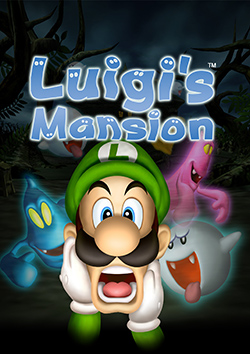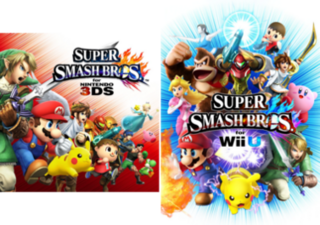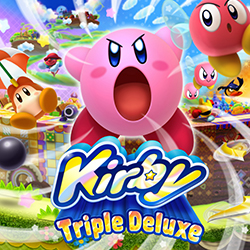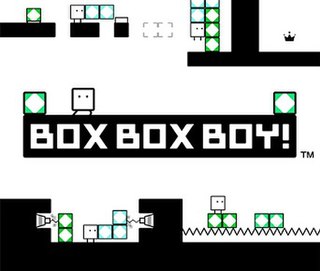
Luigi's Mansion is a 2001 action-adventure game developed and published by Nintendo. The game was a launch title for the GameCube and was the first game in the Mario franchise to be released for the console; it was released in Japan on September 14, 2001, in North America on November 18, 2001, in Europe on May 3, 2002, and in Australia on May 17, 2002. It is the second video game in which Luigi is the main character instead of Mario, after Mario Is Missing!. Players control him as he explores a haunted mansion, searches for Mario and deals with ghosts by capturing them through a vacuum cleaner supplied by Professor E. Gadd.

Kirby is the titular character and protagonist of the Kirby series of video games owned by Nintendo and HAL Laboratory. He first appeared in Kirby's Dream Land (1992), a platform game for the Game Boy. Since then, Kirby has appeared in over 50 games, ranging from action platformers to puzzle, racing, and even pinball, and has been featured as a playable character in every installment of the Super Smash Bros. series (1999–present). He has also starred in his own anime and manga series. Since 1999, he has been voiced by Makiko Ohmoto.

Kirby's Dream Land, known in Japan as Hoshi no Kirby, is a 1992 platform video game developed by HAL Laboratory and published by Nintendo for the Game Boy. It is the first game in the Kirby series and marks the debut of Kirby. It introduced many conventions that would appear in later games in the series. The game follows Kirby as he goes through five levels to retrieve the Sparkling Stars and food of Dream Land from King Dedede.

Kirby's Adventure is a 1993 platform game developed by HAL Laboratory and published by Nintendo for the Nintendo Entertainment System (NES). It is the second game in the Kirby series after Kirby's Dream Land (1992) on the Game Boy and the first to include the Copy Ability, which allows the main character Kirby to gain new powers by eating certain enemies. The game centers around Kirby traveling across Dream Land to repair the Star Rod after King Dedede breaks it apart and gives the pieces to his minions.

Kirby Super Star, released as Kirby's Fun Pak in PAL regions, is an anthology platform video game developed by HAL Laboratory and published by Nintendo for the Super Nintendo Entertainment System in 1996. It is part of the Kirby series of video games by HAL Laboratory. The game was advertised as a compilation featuring eight games: seven short subsections with the same basic gameplay, and two minigames.
Super Smash Bros. is a crossover fighting game series published by Nintendo. The series was created by Masahiro Sakurai, who has directed every game in the series. The series is known for its unique gameplay objective which differs from that of traditional fighters, in that the aim is to increase damage counters and knock opponents off the stage instead of depleting life bars.

Kirby’s Block Ball, known in Japan as Kirby no Block Ball, is a 1995 video game developed by TOSE and Nintendo R&D1 and published by Nintendo for the Game Boy portable console. It is a spin-off of the Kirby video game series. It is a Breakout clone; the player controls paddles along the screen's edge to knock a bouncing ball, Kirby, into destructible bricks. The game's 55 levels include power-ups, bonus rounds, and minigames. The team spent half a year revising the gameplay to match Kirby's signature characteristics. Kirby's Block Ball was released in Japan on December 14, 1995, later in North America on May 13, 1996 and finally in Europe on August 29, 1996.

Kirby is an action-platform video game series developed by HAL Laboratory and published by Nintendo. The series centers around the adventures of a pink round hero named Kirby as he fights to protect and save his home on the distant Planet Popstar from a variety of threats. The majority of the games in the series are side-scrolling platformers with puzzle-solving and beat 'em up elements. Kirby has the ability to inhale enemies and objects into his mouth, spitting them out as a projectile or eating them. If he inhales certain enemies, he can gain the powers or properties of that enemy manifesting as a new weapon or power-up called a Copy Ability. The series is intended to be easy to pick up and play even for people unfamiliar with action games, while at the same time offering additional challenge and depth for more experienced players to come back to.

Mario is a Japanese multimedia franchise created by Japanese game designer Shigeru Miyamoto for video game company Nintendo which produces and publishes its installments. Starring the titular Italian plumber Mario, it is primarily a video game franchise, but has extended to other forms of media, including television series, comic books, a 1993 feature film, a 2023 animated film and theme park attractions. The series' first installment was 1983's Mario Bros., although Mario had made his first appearance in 1981's arcade game Donkey Kong, and had already been featured in several games of the Donkey Kong and Game & Watch series. The Mario games have been developed by a wide variety of developers including Nintendo, Hudson Soft, and AlphaDream. Mario games have been released almost exclusively for Nintendo's various video game consoles and handhelds, from the third generation onward.
Puyo Puyo (ぷよぷよ), previously known as Puyo Pop outside Japan, is a series of tile-matching video games created by Compile. Sega has owned the franchise since 1998, with games after 2001 being developed by Sonic Team. Puyo Puyo was created as a spin-off franchise to Madō Monogatari, a series of first-person dungeon crawler role-playing games by Compile from which the Puyo Puyo characters originated. The series has sold over 9 million copies, including the Madō Monogatari games.

Kid Icarus: Uprising is a third-person shooter video game developed by Project Sora and published by Nintendo for the Nintendo 3DS. Released worldwide in March 2012, it is the third installment in the Kid Icarus franchise, the first to be released since Kid Icarus: Of Myths and Monsters in 1991, and the first worldwide release since the original NES game in 1986. It is also the only video game Project Sora made before shutting down in mid-2012.

Kirby's Epic Yarn is a platform video game developed by Good-Feel and published by Nintendo for the Wii. It is an installment of the Kirby series and was released in October 2010 in Japan and North America and in February 2011 in Australia and Europe. It is the first entry in the Kirby series on a home video game console since 2003's Kirby Air Ride for the GameCube, and its first home console platform game since 2000's Kirby 64: The Crystal Shards for the Nintendo 64.

Super Smash Bros. for Nintendo 3DS and Super Smash Bros. for Wii U are 2014 crossover platform fighter video games developed by Bandai Namco Studios and Sora Ltd. and published by Nintendo for the Nintendo 3DS and Wii U video game consoles. It is the fourth installment in the Super Smash Bros. series, succeeding Super Smash Bros. Brawl. The Nintendo 3DS version was released in Japan on September 13, 2014, and in North America, Europe, and Australia the following month. The Wii U version was released in North America, Europe, and Australia in November 2014 and in Japan the following month.

Kirby: Triple Deluxe is the thirteenth platform and tenth mainline installment of the Kirby video game series, developed by HAL Laboratory and published by Nintendo for the Nintendo 3DS. The game was released in Japan on January 11, 2014, in North America on May 2, 2014, in Europe on May 16, 2014, and in Australia on May 17, 2014. The game follows Kirby as he embarks on a journey through six worlds to rescue King Dedede from Taranza.

Zero Escape, formerly released in Japan as Kyokugen Dasshutsu, is a series of adventure games directed and written by Kotaro Uchikoshi. The first two entries in the series, Nine Hours, Nine Persons, Nine Doors (2009) and Zero Escape: Virtue's Last Reward (2012), were developed by Spike Chunsoft, while the third entry, Zero Time Dilemma (2016), was developed by Chime. Zero Escape is published by Spike Chunsoft in Japan, while Aksys Games and Rising Star Games have published the games for North America and Europe respectively.

Mario vs. Donkey Kong is a crossover spin-off video game series of both the Mario and Donkey Kong franchises, based on puzzle platforming, marking the return of Pauline and the rivalry between Mario and Donkey Kong.

BoxBoxBoy! is a puzzle-platform game developed by HAL Laboratory and published by Nintendo for the Nintendo 3DS handheld game console. The game was released in Japan in January 2016, and in other territories in June 2016. BoxBoxBoy! is a sequel to BoxBoy!, which was released in 2015.

Bye-Bye BoxBoy! is a puzzle-platform game developed by HAL Laboratory and published by Nintendo for the Nintendo 3DS handheld console. The game was released worldwide in 2017, and is a follow-up to BoxBoy! (2015) and BoxBoxBoy! (2016).

BoxBoy! + BoxGirl! is a puzzle-platform game developed by HAL Laboratory and published by Nintendo for the Nintendo Switch. It is the fourth game in the BoxBoy! series, a follow-up to Bye-Bye BoxBoy! (2017), and is first installment to be released outside the Nintendo 3DS. The game features a two-player multiplayer mode, a first for the series.

BoxBoy! is a series of puzzle-platform games developed by HAL Laboratory and published by Nintendo. The series centres around Qbby, a square-shaped character who can produce a string of connected boxes. The boxes are used to overcome obstacles in stages that Qbby must be guided through. The first game, BoxBoy!, released on January 14, 2015, in Japan on the Nintendo 3DS. Its sequel, BoxBoxBoy!, was released for the Nintendo 3DS in 2016, with a third game, Bye-Bye BoxBoy!, in 2017. A physical compilation of the first three games, HakoBoy! Hakozume Box, was released in Japan. A fourth installment, BoxBoy! + BoxGirl!, was released for the Nintendo Switch in April 2019.



















